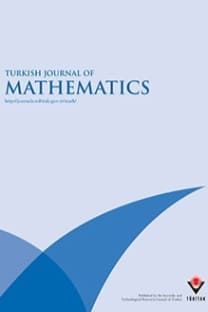On elements whose Moore–Penrose inverse is idempotent in a ∗-ring
On elements whose Moore–Penrose inverse is idempotent in a ∗-ring
___
- [1] Baksalary OM, Trenkler G. Core inverse of matrices. Linear and Multilinear Algebra 2010; 58 (5-6): 681-697. doi: 10.1080/03081080902778222
- [2] Baksalary OM, Trenkler G. On matrices whose Moore-Penrose inverse is idempotent. Linear and Multilinear Algebra 2020. doi: 10.1080/03081087.2020.1781038
- [3] Ben-Israel A, Greville TNE. Generalized Inverses: Theory and Applications. 2nd ed. New York, NY, USA: SpringerVerlag, 2003.
- [4] Bernstein DS. Scalar, Vector, and Matrix Mathematics: Theory, Facts, and Formulas. Princeton, NJ, USA: Princeton University Press, 2018.
- [5] Campbell SL, Meyer CD. EP operators and generalized inverses. Canadian Mathematical Bulletin-Bulletin Canadien de Mathématiques 1975; 18 (3): 327-333. doi: 10.4153/CMB-1975-061-4
- [6] Djordjević DS, Rakočević V. Lectures on Generalized Inverses. Faculty of Sciences and Mathematics, University of Nis. Nis, Serbia: University of Nis, 2008.
- [7] Drazin MP. Pseudo-inverses in associative rings and semigroups. American Mathematical Monthly 1958; 65: 506- 514.
- [8] Han RZ, Chen JL. Generalized inverses of matrices over rings. Chinese Quarterly Journal of Mathematics 1992; 7(4): 40-49.
- [9] Hartwig RE. Block generalized inverses. Archive for Rational Mechanics and Analysis 1976; 61 (3): 197-251. doi: 10.1007/BF00281485
- [10] Hartwig RE, Luh J. A note on the group structure of unit regular ring elements. Pacific Journal of Mathematics 1977; 71(2): 449-461.
- [11] Koliha JJ. Elements of C ∗ -algebras commuting with their Moore-Penrose inverse. Studia Mathematica 2000; 139 (1): 81-90.
- [12] Mosić D, Djordjević DS. Moore-Penrose-invertible normal and Hermitian elements in rings. Linear Algebra and its Applications 2009; 431 (5-7): 732-745. doi: 10.1016/j.laa.2009.03.023
- [13] Mosić D, Djordjević DS, Koliha JJ. EP elements in rings. Linear Algebra and its Applications 2009; 431 (5-7): 527-535. doi: 10.1016/j.laa.2009.02.032
- [14] Patrício P, Puystjens R. Drazin-Moore-Penrose invertibility in rings. Linear Algebra and its Applications 2004; 389: 159-173. doi: 10.1016/j.laa.2004.04.006
- [15] Penrose P. A generalized inverse for matrices. Mathematical Proceedings of the Cambridge Philosophical Society 1955; 51: 406-413.
- [16] Rakić DS, Dinˇcić NC, Djordjević DS. Group, Moore-Penrose, core and dual core inverse in rings with involution. Linear Algebra and its Applications 2014; 463: 115-133. doi: 10.1016/j.laa.2014.09.003
- [17] Xu SZ, Chen JL, Zhang XX. New characterizations for core inverses in rings with involution. Frontiers Mathematics in China 2017; 12 (1): 231-246. doi: 10.1007/s11464-016-0591-2
- [18] Zhu HH, Chen JL, Patrício P. Further results on the inverse along an element in semigroups and rings. Linear and Multilinear Algebra 2016; 64 (3): 393-403. doi: 10.1080/03081087.2015.104371
- ISSN: 1300-0098
- Yayın Aralığı: 6
- Yayıncı: TÜBİTAK
Oscillation tests for nonlinear differential equations with nonmonotone delays
Some properties of second-order weak subdifferentials
Some soft topological properties and fixed soft element results in soft complex valued metric spaces
Estimations on some hybrid exponential sums related to Kloosterman sums
Yingjie CHENG, Xiwang CAO, Liqin QIAN, Jinlong WAN
Dynnikov coordinates on punctured torus
On a fifth-order nonselfadjoint boundary value problem
Operators between different weighted Fréchet and (LB)-spaces of analytic functions
Preservers of the local spectral radius zero of Jordan product of operators
Mhamed ELHODAIBI, Somaya SABER
Hardy–Copson type inequalities for nabla time scale calculus
